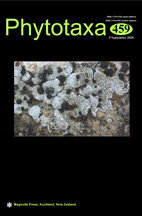Abstract
Miconia dura Triana (1871: 131) has been ignored in taxonomic treatments since Cogniaux (1886-1888, 1891), who treated it as “incertae sedis” or “species dubia”. Cogniaux did not see type specimens of M. dura, nor have more recent taxonomists, because the holotype was destroyed in the Berlin herbarium during World War II. Miconia pennipilis Cogniaux (1887: 287) is a narrowly endemic species, that apparently occurs in only one locality near Ouro Preto, Minas Gerais, Brazil (Rolim 2011). Including Glaziou’s collection of the type of M. pennipilis in 1884, all samples of this species have been gathered in high elevation grasslands at the Pico do Itacolomi, now a state park managed by the government of the state of Minas Gerais. Despite being so rare, this species is very distinctive, mostly because of its unusual inflorescences, which are pendulous, with bifid and secund (scorpioid) branches (Figs. 1, 2). Our curiosity regarding M. dura began while preparing the online monograph on Miconia for the “Flora do Brasil 2020” (see BFG 2018). Looking for characteristics to help us recognize M. dura, we found it to be remarkably similar to M. pennipilis. Furthermore, Triana’s (1871) description of M. dura matches the illustration of M. pennipilis in the Flora Brasiliensis. In conclusion, we propose the synonymization of M. pennipilis Cogn. under M. dura Triana, despite the fact that no evidence other than the description of the latter species is available for its recognition, i.e., no specimen that could be confirmed as a duplicate of the type at B has been found. We also propose here a neotype for M. dura, because the holotype was destroyed, and a lectotype for M. pennipilis, because the description of that species was based on three syntypes.

